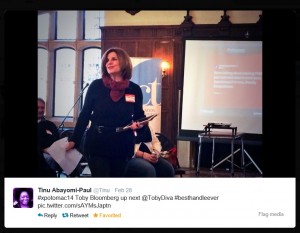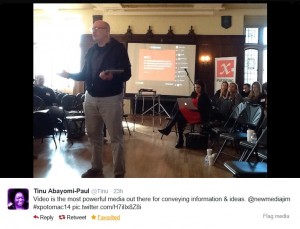 Yesterday I attended xPotomac, a conference on the most influential media technologies most likely to impact businesses and marketers in the immediate future. Both the conference’s content and its organization showcased disrupted shifts in recognizing and harnessing change.
Yesterday I attended xPotomac, a conference on the most influential media technologies most likely to impact businesses and marketers in the immediate future. Both the conference’s content and its organization showcased disrupted shifts in recognizing and harnessing change.
Its organization you ask?
What I found interesting was the fact that none of the speakers used extemporaneous PowerPoints. Instead, they used handhelds with colorful mind maps to remind them where they were in their talk (kudos to Kathryn Garrett for first pointing this out via Twitter). The result was more eye contact and audience interaction than you typically get when speakers are stuck in a pre-personal computer = overhead transparencies paradigm.
The conference room did, however, have a big screen. It was filled with the top tweets and Twitter influencers using the #xPotomac14 hashtag. The result was crowdsourced speaker notes not only perfectly calibrated to audience interests in real time, but also short and sweet enough (due to Twitter’s 140-character limit) to be able to be read quickly without tuning out the speaker. If you have ever developed a PowerPoint, you know it’s hard and time consuming to get buy-in for appropriately concise and readable slides.
This brings me back to a frequent topic, the need to focus many public outreach efforts on mitigating or encouraging specific and pre-determined behaviors appropriate for your audience—not simply raising awareness.
Think about it.
Spreading the word about how great xPotomac’s crowdsourced speaker notes worked is unlikely to result in its replication at conferences outside of tech circles. Touting the benefits of mind maps would be similarly ineffective at invoking change.
Why?
 Because sitting at a conference tweeting on your computer, tablet, or phone is not considered socially acceptable in most venues. Further, most people still are not on Twitter, so the crowdsourced speaker notes would be a flop in most places. Most importantly, the majority of people simply expect to see overhead slides and for audience members to keep their eyes on the speaker or overheads—not their computer, tablet, or phone.
Because sitting at a conference tweeting on your computer, tablet, or phone is not considered socially acceptable in most venues. Further, most people still are not on Twitter, so the crowdsourced speaker notes would be a flop in most places. Most importantly, the majority of people simply expect to see overhead slides and for audience members to keep their eyes on the speaker or overheads—not their computer, tablet, or phone.
The only way an organization could replicate xPotomac’s success is by encouraging Twitter adoption and demonstrating influencers (i.e., bosses and clients in a professional setting) are on board—for both behavior changes.
In other words, to position ourselves and our organizations to compete in the future, it’s not enough to have a few innovators see the potential of the next big thing. It’s a question of reimagining how and why we do things and then ensuring the requisite behaviors are in place, have social support, and are culturally acceptable enough to harness and benefit from the efficiencies of technological change.
That is my main take-away from xPotomac, at least from my strategic communications perspective.




 Most sadly, some of these types of blunders have been known for centuries.
Most sadly, some of these types of blunders have been known for centuries. 
